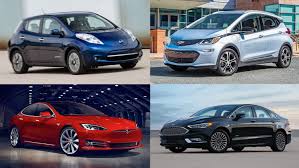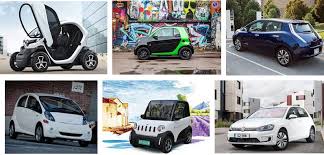Experts have predicted 3 major evolutionary changes in the automotive industry by 2030
 Cars will change in the next decade more than in the last century. And that’s probably a good thing, because cars account for a significant share of global carbon dioxide (CO2) emissions. It is estimated that there are more than 1.37 billion cars in the world, and this figure is expected to rise to 2 billion by 2040.
Cars will change in the next decade more than in the last century. And that’s probably a good thing, because cars account for a significant share of global carbon dioxide (CO2) emissions. It is estimated that there are more than 1.37 billion cars in the world, and this figure is expected to rise to 2 billion by 2040.
There are many innovative ideas on how to deal with emissions from cars: from Hyper-efficient flying cars to hydrogen fuel cells, which as a by-product emit only water, however, this is a distant prospect compared to electric cars and Autonomous cars, which are expected to appear on the roads by 2030.Experts are voicing their thoughts on how a modest car can evolve to become a hero in the global fight against climate change — if they are charged with renewable energy. From China to the Caribbean, experts are exploring initiatives from around the world that are revolutionizing the role cars play.
Whether it’s through fuel economy, a city-wide transportation network, or the use of renewable energy, scientists agree that the cars of the future can be part of a powerful system to reduce greenhouse gas emissions and help manage climate change.
What will the car be like in 2030?
Dan Lewis (Dan Lewis), Claude of Chibelushi (Claude Chibelushi) and Debbie Roberts (Debi Roberts) from Staffordshire University have combined their expertise in the field of industrial design, cognitive computing and transport engineering to look into the future and imagine the car of 2030.
They predict that interiors will become much more flexible, allowing you to customize color, light, privacy and location at the touch of a button — it’s an exciting prospect for passengers. In addition to aesthetics, there are three major changes that experts expect will make cars more efficient and help reduce environmental pollution.
Electrification: electric vehicles currently account for only 2% of the world market. But, according to forecasts, by the mid-2020s, their price will be lower than that of cars with ice, so electric cars should be the choice of a wide range of drivers by 2030.
Automation: by 2030, a standard car will provide both simple driver assistance and full control over all aspects of driving in most cases. Drivers living in suburbs and rural areas are likely to continue to own their own cars, but car sharing (Autonomous) will be popular in cities, which will help to significantly reduce the number of cars on the roads.
Connectivity: minimizes fuel consumption (and improves traffic flow), allowing cars to synchronize their movements. This will be possible thanks to sensors designed to recognize and communicate with upgraded road signs, markings, camera networks, pedestrians and other vehicles.
The electric car revolution is coming
According to Jack Barkenbus of the climate change Research network at Vanderbilt University’s Institute of energy and environment, the global shift from gasoline-powered vehicles to electric vehicles will happen sooner than many think. A key element of the price of an electric car is the cost of its battery, but industry analysts now believe that within five years it will be cheaper to buy an electric car than a car with an engine.
China already produces more than half of the world’s electric vehicles and can continue to produce up to 70% of electric vehicles by 2021, even though demand for electric vehicle batteries is rising.
Most of the demand comes from China, the world’s largest automotive market. As Western countries approach peak levels of car ownership, there are still hundreds of millions of Chinese families who don’t have a car at all, and many of them are buying electric cars.
In 2018, sales of electric cars and plug-in hybrids in China exceeded 1.1 million — more than 55% of all electric cars sold in the world, and more than three times more than Chinese customers bought two years ago. (For comparison, sales of electric vehicles and plug-in hybrids in the US in 2018 reached only 361,000 units).
Batteries of electric vehicles become cheaper very quickly
Batteries of electric vehicles become cheaper very quickly. It is expected that prices will be even lower with the development of technology © inverse.com
Our cities will change as radically as our cars
Most of the world’s population lives in cities, which account for 75% of global energy consumption and 76% of CO2 emissions. In this regard, researchers note that increasing attention is being paid to the role that cities can play in reducing emissions and helping humanity adapt to the effects of climate change.
According to scientists from the University of Sheffield Martin Mayfield (Martin Mayfield) and Giuliano Punzo (Giuliano Punzo), the introduction of electric Autonomous vehicles at the city level will ease congestion, reduce pollution and minimize the time people spend on the road. It will also radically change the face of cities in the future.
The car spends about 90% of its life in the Parking lot. Moving from private vehicles to a service owned and operated by public or private enterprises is a smart and effective solution that revolutionizes urban traffic, but it can have serious consequences for existing transport systems such as trains, subways and buses.
Long-distance transport may suffer as the network of Autonomous vehicles grows and urban operators will have to balance the cost of investment in trains, buses and subways with investment in infrastructure for Autonomous vehicles.
It will probably take 10 to 20 years before Autonomous vehicles — and the 5g high-speed network they will need to connect to — show up on public roads. Meanwhile, scientists note that cities around the world are seeking to reduce car use to reduce CO2 emissions and benefit residents as well as the environment.
Professor and specialist in urban planning Richard Kingston (Richard Kingston) and researcher Ransford Champong (Ransford Acheampong), specializing in urban planning at the University of Manchester, suggest three measures that can reduce the dependence of urban residents from cars without causing them inconvenience.
Enter car-free zones. Car-free zones are designed to limit their use. They may vary in size and nature. In some cities, such as Copenhagen and Brussels, cars are completely banned in some parts of the city center. Other cities, such as Madrid, have imposed partial bans.
The entire city of Ghent, Belgium, is free of cars, but public transport, taxis and other authorized persons may be allowed to pass through the city at speeds of up to five kilometers per hour. In other places, for example, in Central London, charged with drivers traveling during peak hours using or polluting the environment of the vehicle.
Provide alternatives to public transport. Residents may have a negative attitude to restrictions if they cause inconvenience or lead to loss of mobility. An obvious way to solve these problems for cities is to provide people with reliable, flexible and cost-effective public transport. This should pay off in the long run.
Experience shows that the use of cars is already declining in many cities in Europe, the United States and Australia. And young people postpone learning to drive and are less likely to own a car than the previous generation. If less people will drive, that public transport must be available both for young and for older people.
Change the city: cities should be able to allow people to live closer to shops, work and places to relax, so as not to use the car. This can be achieved through the construction of multifunctional buildings with affordable housing and excellent green spaces.
Masdar city in the United Arab Emirates and the Great city in China, prefer pedestrian and public transport instead of cars, and are experimenting with electric vehicles. New developments are aimed at providing basic services, creating safe places for people to walk and providing public transport that uses clean energy.
You need to consider a few things to properly unlock the potential of electric vehicles




